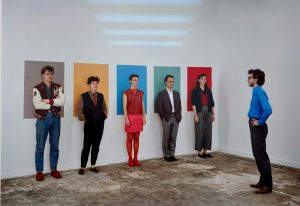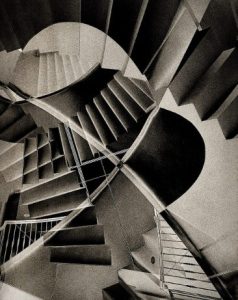
Women Riders (triptych),
לדמויות הנשים האגרסיביות והגסות הרוכבות על גברים עלובים וכנועים, עבדים במשחק שליטה. זיכרון תולדות האמנות שמקופל בעבודה נע מהזאנר הפיסולי של רוכבים על סוסים equestrian statue שמוכר מהפסל של מרקוס אורליוס על גבעת הקפיטול ברומא , דרך הרנסנס עם פסלים מפורסמים של וורוקיו ודונטלו, ועד הפיסול המודרני של מארינו מריני האיטלקי שמוכר בזכות פיסלי רוכבים שזרועותיהם פרושות לצדדים כמו ידי הנשים של אוקון. מאריני מפסל גברים גוצים עם זקפה בולטת שתנוחת הרכיבה היא חלק מהבעה של און ומיניות .
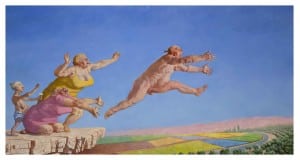
Successful Escape
שלוש נשים שהוא בורח מהן. ההתרסקות, המוות, בלתי נמנעת אך לא נוצרת סימפטיה או הזדהות עימו, אפילו לא אדווה של זעזוע.

detail, Successful Escape
רוכבות, אוקון מתאר ימים של מזג אוויר שימשי מושלם.

Bathing at Hamat Gader
בנוי אך הוא למעשה דיפוזי: ארבע עמודים כחולים מסמנים חלל אך אינם תומכים בדבר,מאחור מה שיכול להיקרא כחומה או קו מתאר של נוף צחיח. מהברכה הירוקה נראה רק קטע קטן בלבד. רחצה ריטואלית, מהטבילה הנוצרית ועד לטבילה במקווה היהודי היא האסוציאציה המידית. העירום מעלה על הדעת בתי מרחץ. גם בסצנה השלווה לכאורה שני גברים מתמוגגים במים, ומאחוריהם מחוץ למים גבר מתמתח ואחר יושב בכסא לא נעלם הטון האירוני.

Bathing at Hamat Gader- detail
הגוף מצויר כבלוי וכעור ומרוקן. יותר משיש סיכוי להיטהרות יש בריחה.
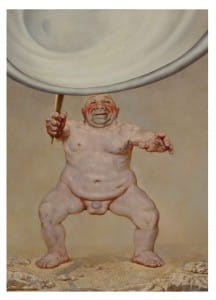
Butterfly Catcher with a White Net
.שלו רודפות ומבקשות לקפד את חייהם של יצורים שגם כך חייהם קצרצרים ולא תהיה להם קמילה.
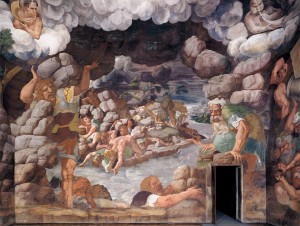
1532-34Fresco
Palazzo del Te, Mantua
התחושב שהם יוצרים: אפשר לחשוב על חדר הענקים בפלאצו טה Palazzo del Te במאנטובה שצייר גוליו רומנו במאה ה 16 או על חלק מהדמויות בקפלה של סן אנטוניו דלה פלורידה במדריד שצייר גויה ב 1799, שני מקומות בהם ציורי קיר מושחזים ופנטסטיים. ההתבוננות של אוקון בעולם, חסרת רחמים. תמצית ההתבוננות, לשד הרדוקציה ליסודות שהוא עושה ליחסים אנושיים אולי אינה מראה מול פני החברה אך היא מחודדת ומדויקת ביחס לעליבות התפיסה ההיררכית של בני אדם לצורך שלעולם יהיה בזוי יותר מהם כנגדו יוכלו לחוש עליונות
Observationes by Sasha Okun
Observationes, the exhibition by Sasha Okun at the Chanan Rozen Museum of Israeli Art Ramat Gan is over, but it provided an opportunity to view Okun’s work, which is almost a one-man school of art.
Since the second half of the 16th century, the Latin word observations was used for a genre of medical literature, which by the 18th century became almost the exclusive method of writing about medicine. When it developed, the emphasis on experience as the source of knowledge, rather than transcendental authority or any other authority, was extremely rare. In time, the total observationes became the repository of knowledge.
Okun contemplates humanity with a distant gaze and a certain empathy, similar to a physician or scientist, sparing nothing from the figures he depicts as eventually “to dust returneth.” He does not poeticize suffering or melancholy, nor does he propose any conclusions or suggestions: Okun observes.
The 12 new works created over the past two years present viewers with a truly operatic drama. These large works, many about three meters wide, all contain figures in extreme situations of conflict, lust, riotous behavior, violence, scenes of pathos and humiliation. A substantial portion of the figures are in extreme contrapposto or are taking huge leaps, with grotesque movements of vitality reminiscent of scenes of the Last Judgment in churches or Israeli playwright Hanoch Levin’s pathetic, battered, but always cruel onstage characters.
Power struggles, unceasing competition, and desperate urges characterize Okun’s figures. He paints men and women in their 60s and 70s, with pendulous muscles and thick flesh, partly or fully nude, in perfect opposition to ideal beauty as defined by Classical Greek Art (muscular men in their 30s in noble poses). Any memory or echo of the erotic is translated into a pathetic attempt to hold onto the libido.

Women Riders (triptych),
In the triptych “Women Riders,” nearly 6 meters wide, Okun attacks several taboos, beginning with his use of the triptych format, with its Christian associations, through to the crude, aggressive females riding on pathetic, submissive men, slaves in the game of control. The art historical memory enfolded in this work moves from the sculptural genre of the equestrian statue, well known since the famous statue of Marcus Aurelius on the Capitoline Hill in Rome, through the Renaissance with works by Verrocchio and Donatello, to the modern Italian sculptor Marino Marini, known for his riders with arms outstretched to the sides like Okun’s female figures.
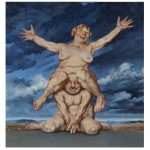
Women Riders (triptych),Details
Marini sculpts dwarfish men with prominent erections whose position astride is part of the expression of potency and sexuality.
Okun’s women give rise to associations with Marini’s figures, but instead of horses, they are riding on the men. The large, Valkyrie-like women are not bearing dead heroes from the battlefield as in Wagner’s operas, but instead are grasping submissive men under their legs;intoxicated with power, they celebrate their victory euphorically. Something about their figures also suggests associations with twisted birth, women giving birth to elderly, ridiculous men, in a scene that can only be bad news.
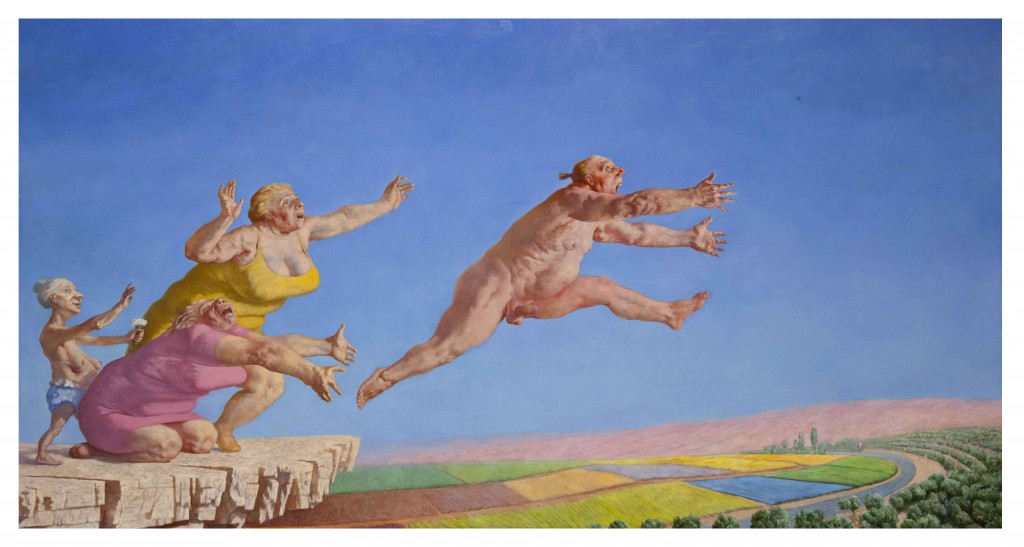
Successful Escape
The large-scale, colorful “Successful Escape” is a painting of a moment of the suicidal and the sublime – a threatening combination, since it is unrestricted by morality or fear. A large man, a hybrid of a Gargantua (Rabelais’s 16th century image) and Disney’s dancing hippopotamus from “Fantasia” leapsover an abyss in flight from three women on a cliff. A crash, followed by death, is inevitable, but no sympathy or identification with the man results, except for a frisson of shock.
The women on the cliff create a parodical and paradoxical situation: their theatrical figures seem characteristic of the Disciples mourning Jesus in various Deposition paintings, especially fromthe Italian Renaissance, but they are far from sacred, in the same way that the man, with his pendulous rolls of flesh and obvious erection is far from the image of Jesus. The women are dressed in the “ice cream colors” of pink, yellow and light blue, and, as in a play by Hanoch Levin, their attempts to please only arouse disgust.
Okun places this absurd drama of escape in a beautiful, peaceful landscape looking

detail, Successful Escape
like the Jezreel Valley on a clear day. The skies are a dreamy, cloudless blue, with colorful rectangular fields, with a chain of sand-colored mountains in the distance. The alienation of the landscape from events taking place within it emphasizes Nature’s indifference to human drama, signifying its triviality in relation to the long processes of the universe. This relation between background and events is much more characteristic of Okun’s work than the stormy, darkening skies in the “Women Riders,” which reinforce the volcanic eruption of the work. In all of the other works in the exhibition, Okun has painted perfect sunny days.
The dichotomy between the landscape and the action, between the description of beauty and the sharp mockery of the figures may be linked to a certain extent with Okun having immigrated to Israel after he nurtured a mythical perception of the Holy Land.
Okun (b. 1949) arrived in Israel from Leningrad (now St. Petersburg) when he was 30. In the USSR, Okun worked at a government academy while simultaneously participating in unofficial artist groups. Israel was seen in the light of the biblical and glorious historical past, as part of the cradle of Western civilization. The encounter with Israeli reality, the rough, sometimes crude, day to day life so lacking in decorum, intensified Okun’s tendency to take a cynical view, which he referred to in our conversations as humor, as well (but which often escaped me).
“Bathing at Hamat Gader” (244×138.5cm) is the only interior scene among his
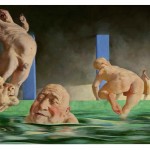
Bathing at Hamat Gader
new works. Although it is an architectural space in the sense that it is constructed, it is actually diffuse: four blue pillars signify a space but support nothing. To the rear is what may be read as a wall or the contour of an arid landscape. We can see only a small section of the green pool. The immediate association is to a ritual bath, from Christian baptism to the Jewish mikveh. The nudity is reminiscent of the bathhouse. The seemingly peaceful scene features two men melting pleasurably into the water while behind them, outside of the water, one man stretches and another sits in a chair. An ironic tone is present in the depiction of the worn-out bodies with empty skin. The scene is more of an escape than a purification.

Bathing at Hamat Gader- detail
Aggression and power plays return in the three “Butterfly catcher” paintings. Nude men with butterfly nets in a dry wilderness are seeking to satisfy the joy of hunting, but the landscape holds out little hope of butterflies. Okun engages in the theme of Time through these figures who are risking their lives in pursuit of short-lived creatures.

Butterfly Catcher
The superb painterly qualities of the paintings link Okun to the European post-Renaissance tradition. Okun’s paintings neither reflect nor imitate. They walk a fine line between caricature and the grotesque, but do not stoop to crudity. His works have been rightly compared to frescoes in terms of the sensation they create. We can think of Giulio Romano’s Hall of the Giants in the Palazzo del Te, Mantua, from the 16th century, or some of the figures in the San Antonio della Florida in Madrid by Goya (1799), both wall paintings full of fantasy and severity.

1532-34Fresco
Palazzo del Te, Mantua
Okun’s observation of the world is pitiless, striving for the essential, to the fundamental reduction of human relations. It is perhaps not a mirror of society, but is sharpened and precise in relation to the pathetic hierarchical perception people have, forever needing someone to be more miserable than they are so they can feel superior.
צילומים: רן ארדה photography: Ran Erde
(except for Palazzo del Te, Mantua)


